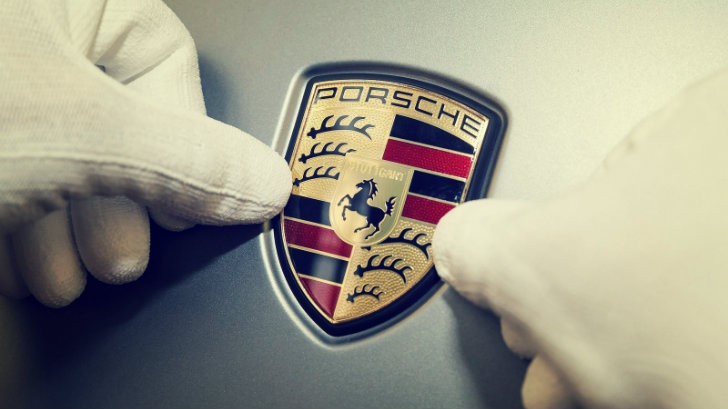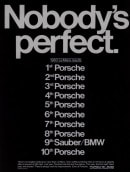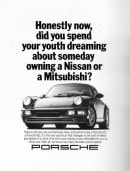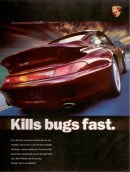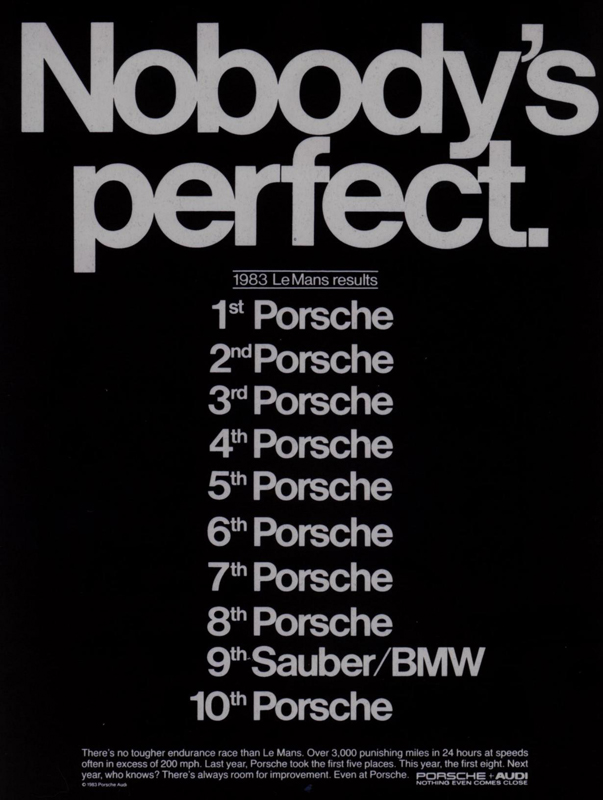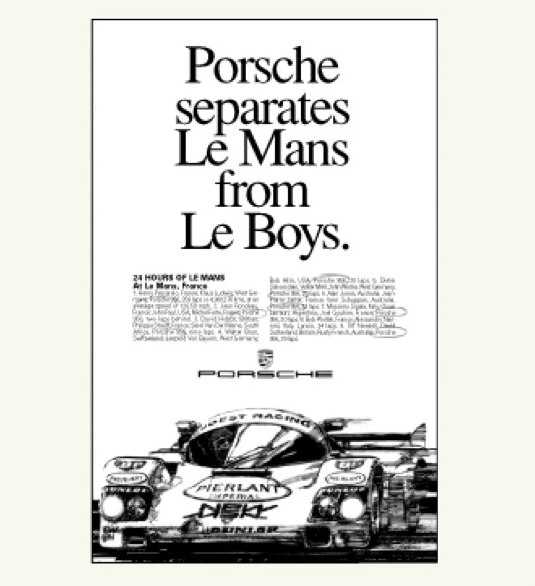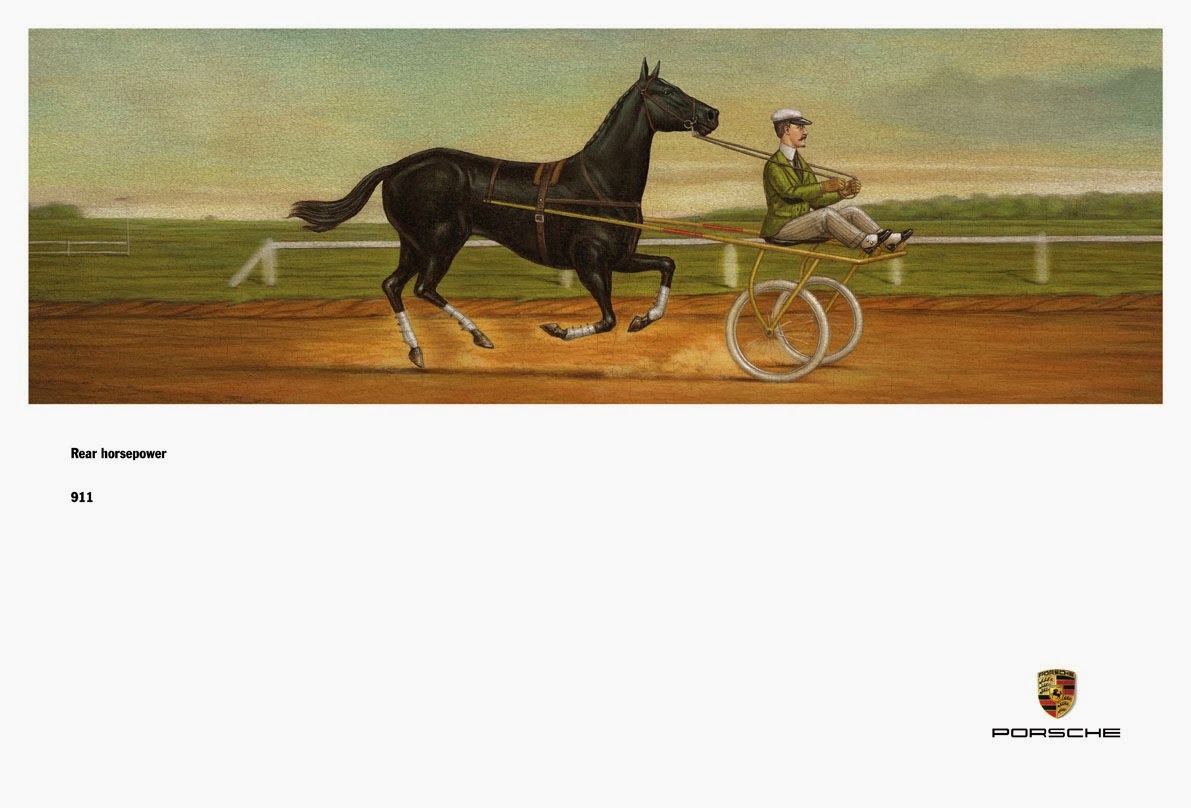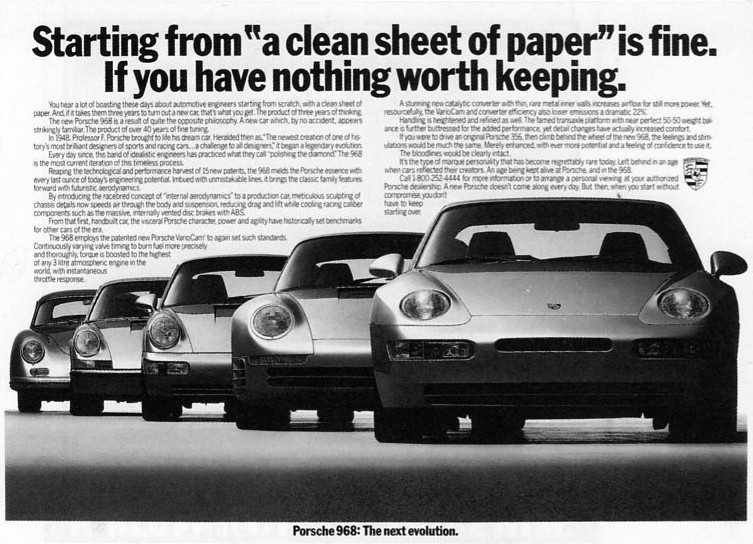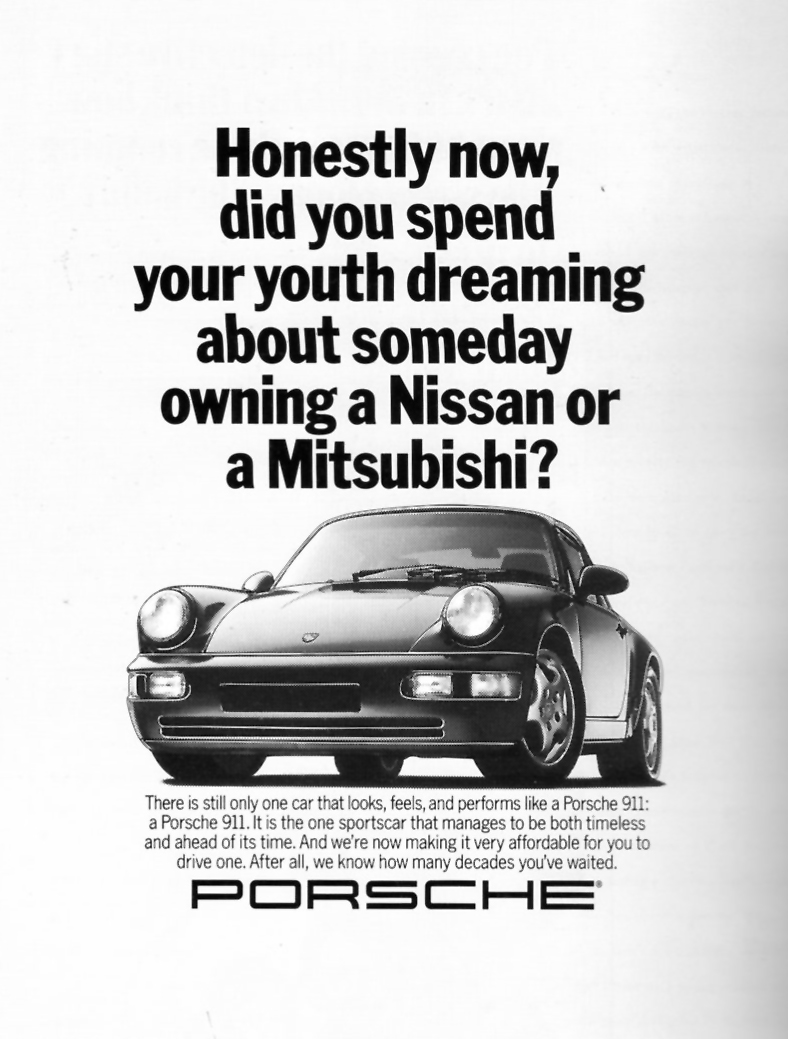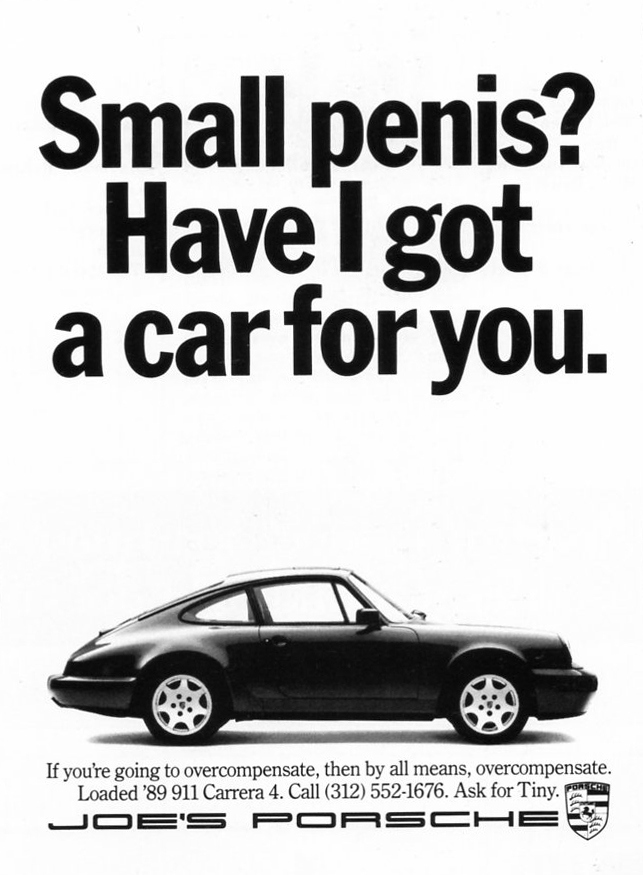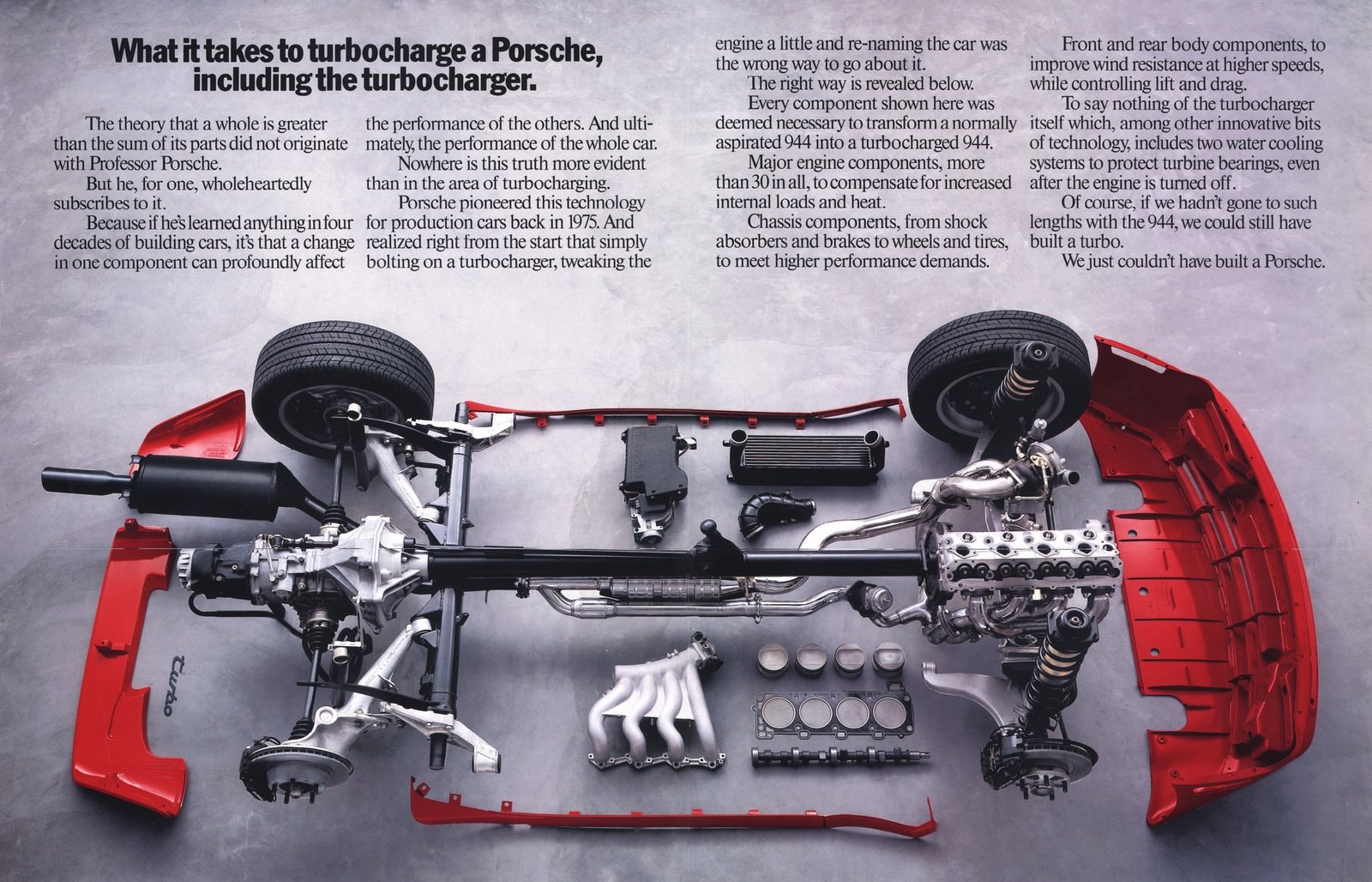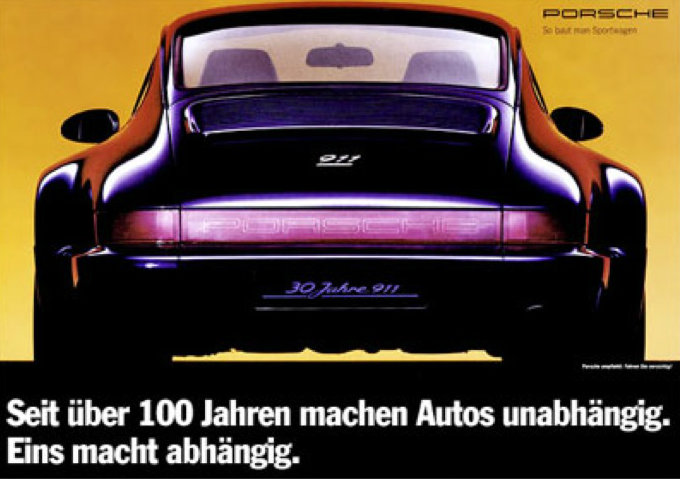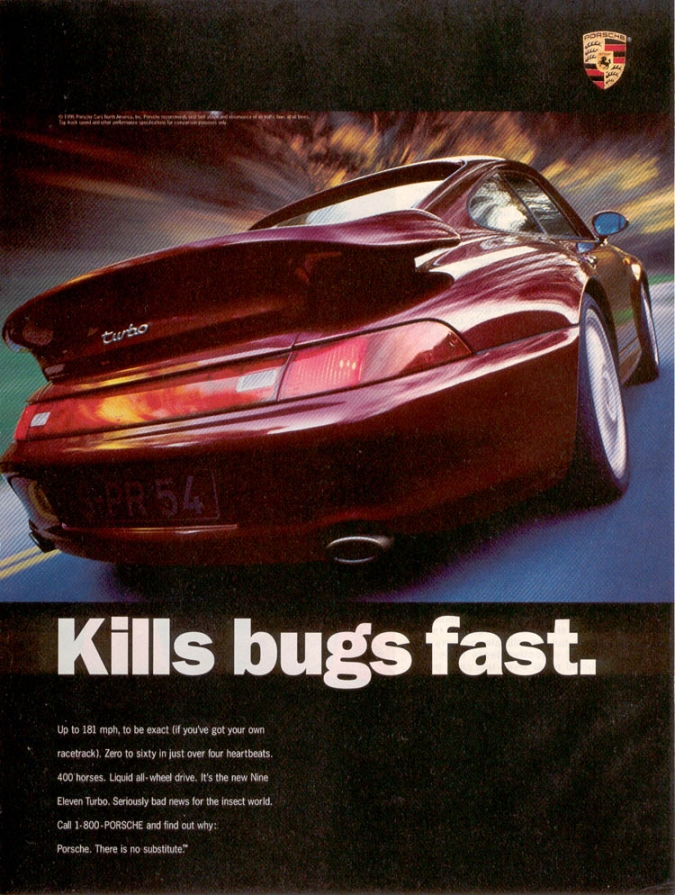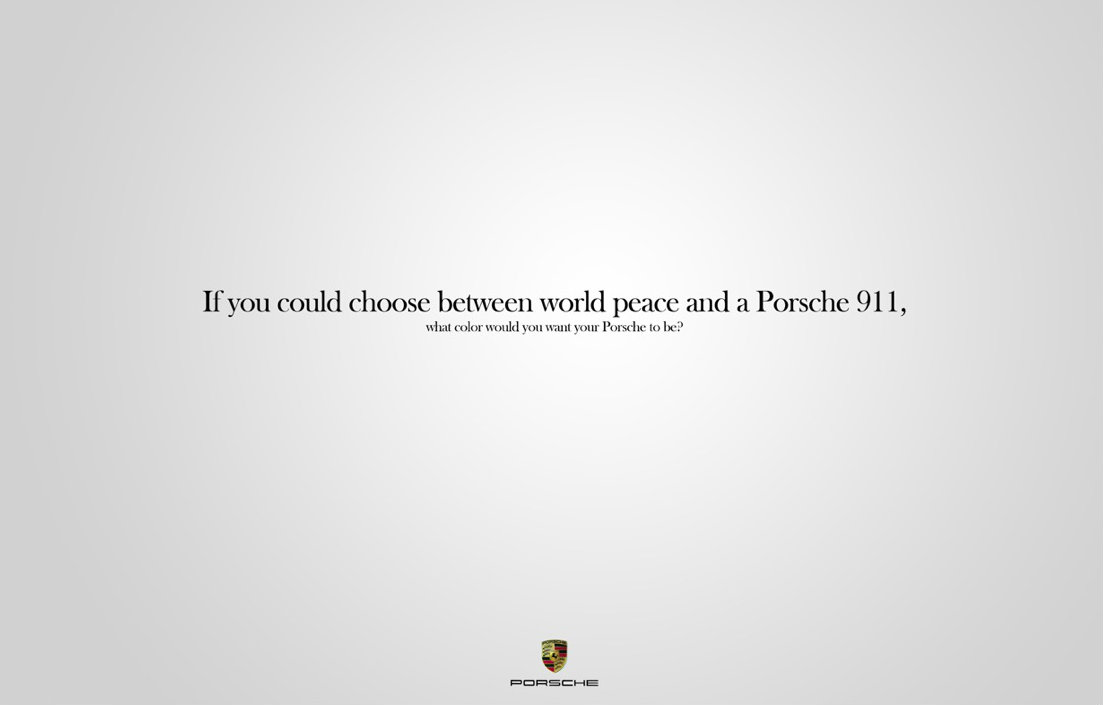Since the dawn of the internal combustion engine, print ads have been the number one marketing medium for car manufacturers around the globe. Out of the few automakers with solid tradition in print advertising, Porsche is considered by marketing experts and motoring editors alike as being the most influential sports car brand to venture into this world.
When it comes to the Stuttgart-based manufacturer, most non-car people think something that goes like: "Aaah, that German company that builds the same Beetle look-alike for some 50 years now?" To them, the iconic 911 is merely a fancy means of transport, but true auto enthusiasts and marketers alike know better than that.
Here's a simple but efficient experiment for the unknowing and skeptics that question Porsche's hierarchy in printed advertising: drive to the nearest petrol station and flick the pages of any mainstream automotive magazine you find there. Yup, most ads are Porsche ads.
These days, Porsche print campaigns emphasize on big sellers like the Cayenne SUV and Panamera four-door saloon. Nevertheless, the German automaker didn't forget about the 911 or its sporting heritage, especially in endurance racing.
Even though Porsche was officially founded in 1931 by automotive engineer Ferdinand Porsche and his son-in-law, the company's first notable print advertising campaigns date from the late '50s and early '60s. As expected, the models advertised were the 356 and the first generation 911.
Ever since, most Porsche print ads followed a simple yet efficient recipe for successful impact on the consumer. Coming in the form of a single page ad, most prints are comprised of a half-page picture of a car, coupled to a brilliant one-liner beneath it, extolling the virtues of driving and owning such an emotional machine.
Of course, great cars like the 911 speak for themselves and yes, Porsche has tons of pedigree up its sleeve and a questionably better historical record than its direct competitors. But in terms of marketing credibility, the German brand employs a simpler, cleverer and more consistent formula than its rivals.
That being said, let's go through some of the best Porsche print ads ever made.
"Nobody's Perfect"
Conceived as a dealer poster and magazine ad for the North American market, this unbearably smug yet cool print is one of the greatest automotive ads ever commissioned.
Out of the top 10 finalists of the 1983 24 Hours of Le Mans endurance race, only Sauber/BMW managed to break Porsche's winning streak with a respectable 9th place.
The power of this ad comes from its ruthless simplicity and carefully dosed sarcasm in the fine print at the bottom.
The amusingly clever wordplay is courtesy of freelance copywriter Gil Zeimer. With a career span of more than 30 years, Zeimer is well known in the industry, having worked as a staff advertising copywriter for large agencies such as BBDO, Ketchum, Grey and Cohn & Wells.
Due to its low profile nature, background info on this ad is unfortunately very limited. However, there is a bit of substance behind that witty tagline.
Starting with Richard Attwood's 1970 Le Mans win at the wheel of the 917K, Porsche amassed a total of 16 overall wins in the prestigious endurance competition. The second most dominant car brand in Le Mans history is Audi, with 12 wins since the year 2000.
The briefing for it was simple: art director and copywriter Laurent Leccia was asked by Porsche China to come up with a graphic representation of the 911's trademark feature: its rear-engine layout.
Amusingly, Leccia's idea came from the year this ad was commissioned. Because 2013 is symbolized in the Chinese calendar by the horse, the final design of the print featured a stallion pushing a two-wheeled racing cart to visually demonstrate the highlight feature of Porsche's iconic 911.
Referring to the 'evolution' part, the 968 was more of a 944 Version 2.0 than an all-new model. Hardcore Porsche aficionados will tell you that the two-door 968 took over more than 20 percent of its predecessor's components, mostly mechanical by nature, in order to cut development costs.
However, the 968 had its fair share of "clean sheet of paper" features. This was the first Porsche model benefitting from VarioCam, the automaker's first production continuous valve timing technology. Also, no other naturally aspirated 3.0-liter engine at the time benefited from such a high torque figure.
However, when the 964 arrived at the end of the '80s, the EVO didn't exist, while the R32 Skyline GT-R churned out 276 horsepower and 368 Nm of torque in top-of-the-range V-Spec II guise.
Compare those figures with the 964 Turbo 3.6-liter's 360 horsepower and 520 Nm of tire shredding torque and you get the picture.
For those more into advertising than the car itself, this ad was made by Fallon McElligott advertising agency for Porsche Cars North America.
The devil is in the details. Specifically, the '4' in the 1989 model year 911 Carrera 4 advertised. Porsches of yesteryear are known for their tail happy behavior round corners.
Most petrolheads certainly heard the "Slow in, fast out" mantra, which defines the mid-corner dynamics of old school two-wheel drive 911s. However, the 964 Carrera 4 was the first ever production 911 equipped with four-wheel drive.
With double the amount of traction, the 964 Carrera 4 was the way to go if you wanted to impress the ladies with heroic driving round corners, even if your fingers were actually made out of butter.
Without question, this piece of classic print advertising gave German automotive magazine AutoBild the idea of disassembling cars after they've been tested for endurance, in order to analyze the wear and tear of the drivetrain's components.
Despite the apparently outlandish creative direction, the word-based ad is heavily inspired by Doyle Dane Bernback's pioneering print ads for the VW Beetle from the 60's. Nevertheless, its creator takes the subtlety of its predecessor up a notch or two by not featuring even a single Porsche logo anywhere.
The 'One' that German agency Jung von Matt is talking about is the highly collectible 964 Turbo 30th Anniversary Edition. Published at the dawn of the '90s, this campaign was specifically made to reach a younger German audience (note the "independece"), not the typical accomplished business man.
Creating a need to feel the addiction of the 911, the visual identity of the print is dominated by two simple elements with a big impact: see the front of the vehicle facing the orange background? A young aspirational man would correlate that with driving the car towards the sunset, to a bright future.
And then came the 993 Turbo. "Kills bugs fast" is one of the more straight-forward ads from Porsche, featuring an action photograph of the vehicle accelerating mid-corner and a short description of its performance stats.
Our favorite detail of the ad is the "Porsche. There is no substitute" tagline serving as the print's ending. Nevertheless, this saying goes back a long way in Porsche advertising history, but it's been made famous by a young Tom Cruise acting as a spoiled high school student in 1983's "Risky Business."
The young artist hit the nail on the head with the copywriting featured in this ad. Seriously now, that's a very well put together message, full of intrigue, which speaks to a wide range of audiences. Young or old, poor or rich, virtually everyone that dreamt with their eyes open about a brighter tomorrow.
Speaking of which, what color would you want your Porsche to be?
Here's a simple but efficient experiment for the unknowing and skeptics that question Porsche's hierarchy in printed advertising: drive to the nearest petrol station and flick the pages of any mainstream automotive magazine you find there. Yup, most ads are Porsche ads.
These days, Porsche print campaigns emphasize on big sellers like the Cayenne SUV and Panamera four-door saloon. Nevertheless, the German automaker didn't forget about the 911 or its sporting heritage, especially in endurance racing.
Even though Porsche was officially founded in 1931 by automotive engineer Ferdinand Porsche and his son-in-law, the company's first notable print advertising campaigns date from the late '50s and early '60s. As expected, the models advertised were the 356 and the first generation 911.
Ever since, most Porsche print ads followed a simple yet efficient recipe for successful impact on the consumer. Coming in the form of a single page ad, most prints are comprised of a half-page picture of a car, coupled to a brilliant one-liner beneath it, extolling the virtues of driving and owning such an emotional machine.
Of course, great cars like the 911 speak for themselves and yes, Porsche has tons of pedigree up its sleeve and a questionably better historical record than its direct competitors. But in terms of marketing credibility, the German brand employs a simpler, cleverer and more consistent formula than its rivals.
That being said, let's go through some of the best Porsche print ads ever made.
"Nobody's Perfect"
Conceived as a dealer poster and magazine ad for the North American market, this unbearably smug yet cool print is one of the greatest automotive ads ever commissioned.
Out of the top 10 finalists of the 1983 24 Hours of Le Mans endurance race, only Sauber/BMW managed to break Porsche's winning streak with a respectable 9th place.
The power of this ad comes from its ruthless simplicity and carefully dosed sarcasm in the fine print at the bottom.
"Porsche separates Le Mans from Le Boys"
Well well well, what do we have here? One of the most obscure Porsche prints ever pinpoints in a very tongue-in-cheek way the difference between gentlemen and boy racers.The amusingly clever wordplay is courtesy of freelance copywriter Gil Zeimer. With a career span of more than 30 years, Zeimer is well known in the industry, having worked as a staff advertising copywriter for large agencies such as BBDO, Ketchum, Grey and Cohn & Wells.
Due to its low profile nature, background info on this ad is unfortunately very limited. However, there is a bit of substance behind that witty tagline.
Starting with Richard Attwood's 1970 Le Mans win at the wheel of the 917K, Porsche amassed a total of 16 overall wins in the prestigious endurance competition. The second most dominant car brand in Le Mans history is Audi, with 12 wins since the year 2000.
"Rear horsepower"
The product of Fred & Farid's Chinese branch, the "Rear horsepower" outdoor print is one of the more interesting Porsche ads from recent years.The briefing for it was simple: art director and copywriter Laurent Leccia was asked by Porsche China to come up with a graphic representation of the 911's trademark feature: its rear-engine layout.
Amusingly, Leccia's idea came from the year this ad was commissioned. Because 2013 is symbolized in the Chinese calendar by the horse, the final design of the print featured a stallion pushing a two-wheeled racing cart to visually demonstrate the highlight feature of Porsche's iconic 911.
"Porsche 968: The next evolution"
"The next evolution" print advertising campaign was comprised of several different ads built around the 968 model. Sold from 1992 through 1995, it took the entry-level position in the German manufacturer's lineup from the 944.Referring to the 'evolution' part, the 968 was more of a 944 Version 2.0 than an all-new model. Hardcore Porsche aficionados will tell you that the two-door 968 took over more than 20 percent of its predecessor's components, mostly mechanical by nature, in order to cut development costs.
However, the 968 had its fair share of "clean sheet of paper" features. This was the first Porsche model benefitting from VarioCam, the automaker's first production continuous valve timing technology. Also, no other naturally aspirated 3.0-liter engine at the time benefited from such a high torque figure.
"Honestly now, did you spend your youth dreaming about someday owning a Nissan or Mitsubishi?"
Actually, yes. There's nothing wrong with taking a Nissan GT-R or a Mitsubishi Lancer EVO X over a bona fide sports car made in Europe.However, when the 964 arrived at the end of the '80s, the EVO didn't exist, while the R32 Skyline GT-R churned out 276 horsepower and 368 Nm of torque in top-of-the-range V-Spec II guise.
Compare those figures with the 964 Turbo 3.6-liter's 360 horsepower and 520 Nm of tire shredding torque and you get the picture.
For those more into advertising than the car itself, this ad was made by Fallon McElligott advertising agency for Porsche Cars North America.
"Joe's Porsche - Have I got a car for you"
Undoubtedly the most adventurous and sexist Porsche print ad ever, the flippant message featured shouldn't be taken literally.The devil is in the details. Specifically, the '4' in the 1989 model year 911 Carrera 4 advertised. Porsches of yesteryear are known for their tail happy behavior round corners.
Most petrolheads certainly heard the "Slow in, fast out" mantra, which defines the mid-corner dynamics of old school two-wheel drive 911s. However, the 964 Carrera 4 was the first ever production 911 equipped with four-wheel drive.
With double the amount of traction, the 964 Carrera 4 was the way to go if you wanted to impress the ladies with heroic driving round corners, even if your fingers were actually made out of butter.
"What it takes to turbocharge a Porsche"
Ah, now this is a very fine print. This ad was used to promote the top-of-the-range 944 Turbo model, which was then the 911's smaller and less expensive brother.Without question, this piece of classic print advertising gave German automotive magazine AutoBild the idea of disassembling cars after they've been tested for endurance, in order to analyze the wear and tear of the drivetrain's components.
Despite the apparently outlandish creative direction, the word-based ad is heavily inspired by Doyle Dane Bernback's pioneering print ads for the VW Beetle from the 60's. Nevertheless, its creator takes the subtlety of its predecessor up a notch or two by not featuring even a single Porsche logo anywhere.
"Seit uber 100 Jahren machen Autos unabhangig. Eins macht abhangig."
In English, that translates to "For over 100 years, cars created independence." Nicely put and inspirational. But the punchline stands in the way it ends, with "One creates dependence."The 'One' that German agency Jung von Matt is talking about is the highly collectible 964 Turbo 30th Anniversary Edition. Published at the dawn of the '90s, this campaign was specifically made to reach a younger German audience (note the "independece"), not the typical accomplished business man.
Creating a need to feel the addiction of the 911, the visual identity of the print is dominated by two simple elements with a big impact: see the front of the vehicle facing the orange background? A young aspirational man would correlate that with driving the car towards the sunset, to a bright future.
"Kills bugs fast"
In the 1990s, the supercar was virtually dead. Only Ferrari and Lamborghini were offering models that looked great, had enough horsepower under their hoods and handled better than run-of-the-mill sports cars of the era.And then came the 993 Turbo. "Kills bugs fast" is one of the more straight-forward ads from Porsche, featuring an action photograph of the vehicle accelerating mid-corner and a short description of its performance stats.
Our favorite detail of the ad is the "Porsche. There is no substitute" tagline serving as the print's ending. Nevertheless, this saying goes back a long way in Porsche advertising history, but it's been made famous by a young Tom Cruise acting as a spoiled high school student in 1983's "Risky Business."
"If you could choose between world peace and a Porsche 911, what color would you want your Porsche to be?"
Created by 20-year-old Jack Lin, an up-and-coming graphic designer currently studying at the School of Visual Arts in New York, this isn't an official Porsche ad. But it should be...The young artist hit the nail on the head with the copywriting featured in this ad. Seriously now, that's a very well put together message, full of intrigue, which speaks to a wide range of audiences. Young or old, poor or rich, virtually everyone that dreamt with their eyes open about a brighter tomorrow.
Speaking of which, what color would you want your Porsche to be?
